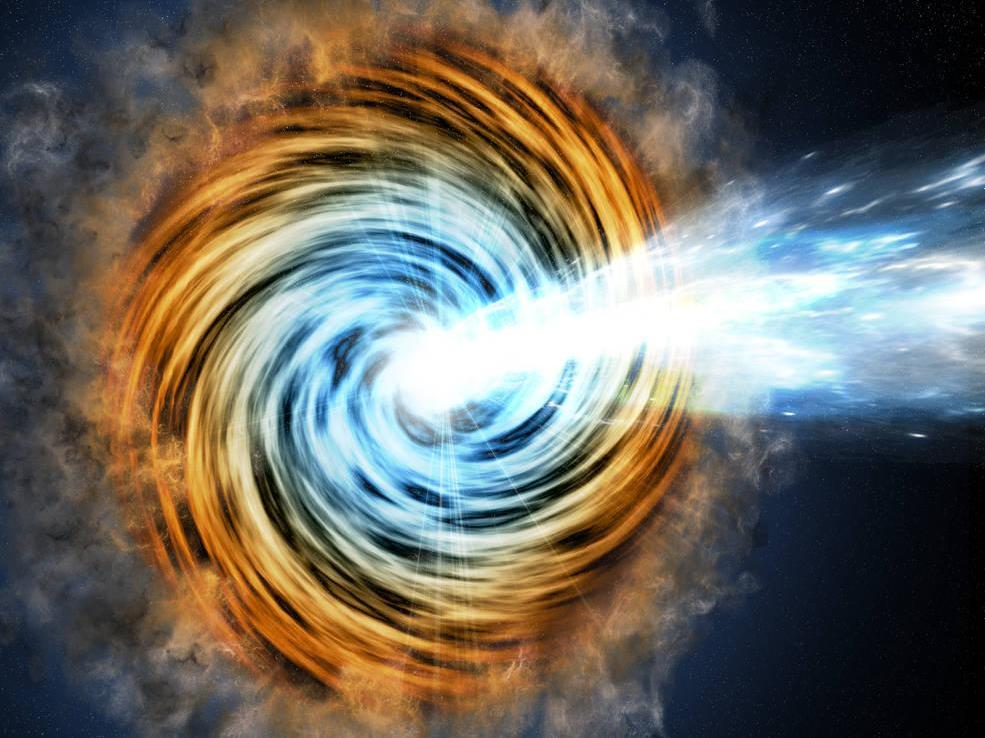2023-05-10 ペンシルベニア州立大学(PennState)

For some supermassive black holes, matter outside the event horizon is propelled at high speed in a jet that can be detected across the universe. When the jet is pointed in the direction of the Earth, it is typically called a blazar. Penn State researchers have characterized more than a hundred relatively dim blazars and used them to test a contentious theory of blazar emissions. Credit: NASA/JPL-Caltech/GSFC. All Rights Reserved.
◆ブレーザーは、中心にスーパーマスのブラックホールを持つ、遠い宇宙の活動的な銀河で、強力なジェットを発生させる。光が全電磁スペクトルにわたって放射されるため、ブレーザーは宇宙の中でも目立つ存在だ。
◆研究者たちは、新しいブレーザーの中でも暗いものを用いて「ブレイザーシークエンス」と呼ばれる理論をテストし、ブラックホールの成長、一般相対性理論、高エネルギー物理学の理論を理解する上で重要な手掛かりを得た。
◆詳細は Astrophysical Journal に掲載される。
<関連情報>
- https://www.psu.edu/news/eberly-college-science/story/testing-theory-supermassive-black-holes-100-newly-described-blazars/
- https://arxiv.org/abs/2305.02087
フェルミ非関連カタログから最近発見された薄暗いブレイザーのスペクトルを使ってブレイザーシークエンスを検証する。
Testing the Blazar Sequence with Spectra of Recently Discovered Dim Blazars from the Fermi Unassociated Catalog
Stephen Kerby, Abraham D. Falcone
arXiv Submitted on :3 May 2023
DOI:https://doi.org/10.48550/arXiv.2305.02087
Recent works have developed samples of blazars from among the Fermi-LAT unassociated sources via machine learning comparisons with known blazar samples. Continued analysis of these new blazars tests the predictions of the blazar sequence and enables more flux-complete samples of blazars as a population. Using Fermi, Swift, WISE, and archival radio data, we construct broadband spectral energy distributions for 106 recently identified blazars. Drawn from the unassociated 4FGL source sample, this new sample has a lower median flux than the overall sample of gamma-ray blazars. By measuring the synchrotron peak frequency, we compare our sample of new blazars with known blazars from the 4LAC catalog. We find that the bulk of the new blazars are similar to High-Synchrotron Peak (HSP) BL Lac objects, with a higher median synchrotron peak; the sample has a median log(νsyn/Hz)=15.5 via BLaST peak estimation, compared to log(νsyn/Hz)=14.2 for the 4LAC BL Lacs. Finally, we conduct synchrotron self-Compton (SSC) leptonic modeling, comparing fitted physical and phenomenological properties to brighter blazars. We find that the new blazars have smaller characteristic Lorentz factors γboost and fitted magnetic fields B, in agreement with blazar sequence predictions. The new blazars have slightly higher Compton dominance ratios than expected, which may point to alternative emission models for these dim blazars. Our results extend the predictions of the blazar sequence to a sample of dimmer blazars, confirming the broad predictions of that theory.


